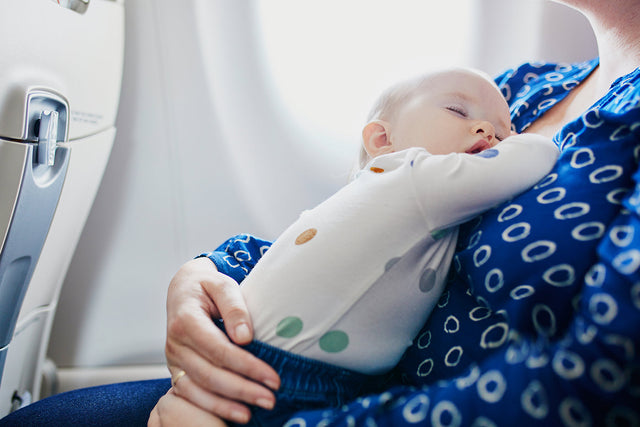8 Tips That’ll Take the Stress Out of Flying With a Baby

Flying with a baby is a nerve-wracking rite of passage for many parents. Not only do you have to navigate the logistics of traveling with a baby in tow (you’re probably wondering how a small person could require so much gear!), but there are a bunch of other worries to occupy your mind. How will your baby deal with the change in air pressure? How will you protect them from the germy plane? And how will you fend off the glares from other passengers when they cry?
Deep breath. Up until about a hundred years ago, nobody traveled with their kids. It’s a very recent phenomenon that poses a big challenge for babies and parents…so cut yourself some slack! While babies on planes get a bad rap, when we fly, we're bound to encounter all kinds of people, behaviors, and sounds! For example, are a grown man’s loud snores any worse than your little one’s wails? I can’t solve the snore intrusion, but I may be able to help you bypass some nasty looks with advice for soothing your baby and other tips for a stress-free flight. Here, my best tips for flying with a baby:
Encourage sucking at takeoff and landing.
The change in air pressure at takeoff and landing may hurt your baby’s ears, but sucking on the breast, a bottle, or an eyedropper can help. Swallowing intermittently will help equalize the pressure in their ears. The key is to time it right. If you offer a bottle at takeoff, it might be gone by the time you get to the altitude when pressure really starts to change. Instead, plan to offer the bottle about 3 to 4 minutes after wheels are up. Likewise, when it comes to landings, the baby should start sucking about 30 minutes before you touch down. When the captain lets you know you’re in descent…that’s your cue!
Get to the airport early.
Gone are the days when you could zip through the airport with the speed of a 747. Now, you’ll be traveling with not just an infant in tow, but possibly their stroller, car seat, and baby bed. In addition to being weighed down by the extra baggage, expect your trip through TSA to take a few more minutes than usual. While you’re allowed to carry on breastmilk, formula, and baby food in quantities that exceed TSA’s 3.4-ounce rule, TSA agents will need to inspect it. And, of course, you’ll want to make sure you have enough time to hit the changing table before you board the plane. (Yes, the aircraft should be equipped with a changing table in the restroom—but airplane bathrooms aren’t exactly roomy.)
Wipe down your surroundings.
Though people tend to fret about germs in the recirculated plane air, research suggests that much more illness is spread through touch. Once you’re on the plane, it's a good idea to wipe down the seat, tray table, seatbelt, armrests, and anything else your little one can get their hands or mouth on. And while you’re at it…
Scrub your hands.
And I mean scrub. To banish germs from your skin, you need to vigorously rub them off—a quick rinse won’t cut it. If you find yourself in a situation where you can’t get to soap and water (maybe you find yourself trapped in your seat after the captain has illuminated the fasten seatbelt sign), rubbing your hands on your pants is a quick way to cut down on germ transfer in a pinch.
Put the 5 S’s into practice.
Good news! The 5 S’s for soothing babies work at all elevations! Swaddle your baby, place them on their stomach or side, and give them a pacifier to suck on. Whenever you can, get out of your seat and walk up and down the aisles to give your baby the rhythmic swinging movement she needs as you shush loudly in their ear. (Fortunately, there’s one way in which being on a plane works in your favor: The ambient whooshing sound in the cabin may double as white noise, taking care of the shushing part of the 5 S’s. Another idea: Stash SNOObear—a cute on-the-go sound machine—in your bag so it’s ready for air travel, the car ride, and beyond! (Bonus: SNOObear doubles as a fun puppet, perfect for mid-flight entertainment!)
Stash emergency supplies in your carry-on.
We all hope our baggage arrives at our destination with us…but just in case it doesn’t, you’ll want to pack the essentials in your carry-on. That includes any in-case-of-emergency supplies, such as your thermometer, baby Tylenol or Motrin, as well as your pump, expressed milk, bottles, and/or formula, depending on how you’re feeding your baby. Diaper cream might come in handy, too, since baby will likely be sitting longer than usual.
Bring a change of clothes—for baby and yourself.
Diaper blowouts, leaks, and spit-up eruptions are not strictly earthbound events! And there are few things worse than having to endure a full flight soaked in your baby’s mess, so come prepared with a spare outfit (and a wet bag!)…just in case!
Pack some self-compassion…and a sense of humor.
Expect that something crappy is probably going to happen, but know that you’re doing your best, and that’s all anyone can hope for. This isn’t easy! Once you exit the plane, give yourself a much-deserved pat on the back. You did it!